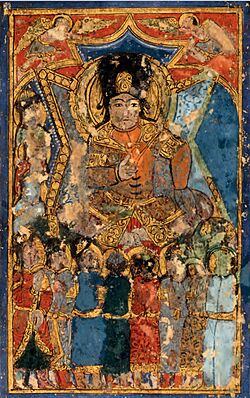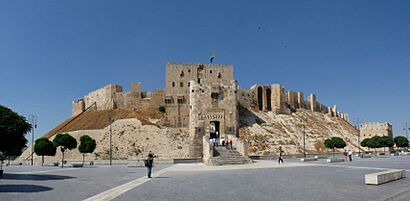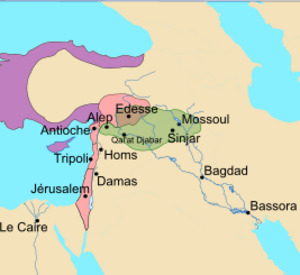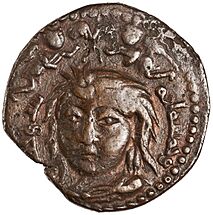Imad al-Din Zengi facts for kids
Quick facts for kids Imad al-Din Zengi |
|||||
|---|---|---|---|---|---|
| Atabeg of Mosul, Aleppo, Hama and Edessa, Mesopotamia | |||||

Ruler in Turkic military dress: long braids, sharbush fur hat, boots, close-fitting coat. Maqamat by Al-Hariri of Basra (1054–1122), a high government official of the Seljuks. Mesopotamia, possibly Baghdad, 1237 copy.
|
|||||
| Atabeg of Zengid dynasty | |||||
| Reign | 1124-1127: Seljuk Governor of Wasit and Basra 1126-1127: Seljuk Shihna, Governor of Iraq |
||||
| Coronation | 1127, Mosul | ||||
| Successor | Nur ad-Din Zengi (in Aleppo) Sayf al-Din Ghazi I (in Mosul) |
||||
| Born | 1085 | ||||
| Died | September 14, 1146 (aged 61) Qal'at Ja'bar, Syria |
||||
| Spouse | Zumurrud Khatun Sukmana Khatun Safiya Khatun |
||||
|
|||||
| Dynasty | Zengid dynasty | ||||
| Father | Aq Sunqur al-Hajib | ||||
| Religion | Islam | ||||
| Military career | |||||
| Battles/wars |
|
||||
Imad al-Din Zengi (born around 1085 – died September 14, 1146), also known as Zangi, was a powerful Turkoman ruler. He was an atabeg (a governor or guardian of a prince) of the Seljuk Empire. Zengi ruled over important cities like Mosul, Aleppo, Hama, and later Edessa. He founded the Zengid dynasty, a family of rulers who played a big role in the history of the Middle East.
Contents
Zengi's Early Life and Military Career
Zengi's father, Aq Sunqur al-Hajib, was a governor of Aleppo. Sadly, his father was executed in 1094 when Zengi was only about 10 years old. After this, Zengi was raised by Kerbogha, who was the governor of Mosul.
As he grew up, Zengi joined the military forces of the governors of Mosul. He served under several leaders, including Jawali Saqawa and Mawdud. From 1114, he served under Aqsunqur al-Bursuqi. Zengi stayed in Mosul until 1118. Then, he began working for the new Seljuk ruler, Mahmūd.
Rising to Power in Iraq
The region of Mesopotamia (modern-day Iraq) was under the control of the Seljuk Empire for many years. In 1122, Mahmūd II, the Seljuk ruler, ordered a military mission to southern Iraq. Zengi was given his first major military command during this mission. He led his troops near Wasit and was made governor of that area.
Working with the Caliph's (the religious and political leader of the Muslim world) troops, Zengi defeated a local leader named Dubays in 1123. Because of his success, Zengi was also made the military governor of Basra in 1124.
The Seljuks later fought against the Abbasid Caliph al-Mustarshid, who wanted more power. Zengi showed strong leadership in this campaign. The Seljuks took control of Baghdad and the Caliph's palace. The Caliph had to agree to peace and pay a large sum of money. In April 1126, Zengi was promoted again. He became the governor of Baghdad and received the title of shihna. This meant he was in charge of the entire Seljuk region of Iraq. In 1127, after the death of Aqsunqur al-Bursuqi, Zengi was named governor of Mosul. This is where the Zengid family began its rule.
Becoming Atabeg of Mosul and Aleppo
In 1128, the ruler of Damascus died, creating a chance for the Crusaders to attack Syria. Zengi became the atabeg (governor) of Mosul in 1127 and of Aleppo in 1128. He brought these two important cities under his control. The Seljuk Sultan Mahmud II officially recognized him as their ruler. Zengi had supported the young Sultan against his rival, the Caliph al-Mustarshid.
Zengi's Campaigns Against Damascus
In 1130, Zengi made an alliance with the ruler of Damascus, but it was a trick to gain more power. He captured the ruler's son and took the city of Hama. Zengi also tried to capture Homs but failed. He returned to Mosul, where the prisoners from Damascus were later freed for a large payment.
When Mahmud II died in 1131, a fight for who would rule next began among the Seljuk princes. Zengi tried to take Baghdad for himself but was defeated by the Caliph's army. He escaped thanks to the help of Najm ad-Din Ayyub, the governor of Tikrit. This governor would later become the father of the famous Saladin. Years later, Zengi rewarded Najm ad-Din Ayyub with a position in his army, which helped Saladin's future career.

In 1135, Zengi received a request for help from Shams ul-Mulk Isma'il, the ruler of Damascus. Isma'il was afraid of his own people and wanted to give the city to Zengi for peace. However, Isma'il's mother, Zumurrud, murdered him to stop him from handing over Damascus. Isma'il's brother, Shihab al-Din Mahmud, became the new ruler.
Zengi still wanted Damascus and attacked it. The siege lasted for some time, but Zengi could not capture the city. Eventually, a truce was made. Zengi then gave up the siege and returned to Aleppo. On his way back, he attacked Homs.
Wars Against Crusaders and Byzantines
In 1137, Zengi attacked Homs again, but it was successfully defended. In response, Damascus formed an alliance with the Crusader Kingdom of Jerusalem against Zengi.
In the Battle of Ba'rin (also called the Battle of Montferrand) in 1137, Zengi's forces defeated a Crusader army led by King Fulk of Jerusalem. This victory meant the Crusaders lost their castle of Montferrand. King Fulk was allowed to leave with his remaining soldiers.
Facing the Byzantine-Crusader Alliance

Zengi realized that attacking Damascus again would be difficult. He made peace with its ruler just in time to face a large army sent by the Byzantine Emperor John II Comnenus. The Emperor had recently taken control of the Crusader Principality of Antioch and joined forces with Joscelin II of Edessa and Raymond of Antioch.
Facing this combined Byzantine and Crusader threat, Zengi gathered his own forces and got help from other Muslim leaders. In April 1138, the Byzantine and Crusader armies began to besiege Shaizar. However, Zengi's forces managed to drive them back a month later.
The Siege of Baalbek
In May 1138, Zengi made a deal with Damascus. He married Zumurrud Khatun, the same woman who had murdered her son Isma'il. As part of the marriage agreement, Zengi received Homs. In July 1139, Zumurrud's other son, Shihab al-Din, was killed. Zengi then marched on Damascus to take the city.
The people of Damascus, led by Mu'in al-Din Unur, once again allied with Jerusalem to fight off Zengi. Zengi also besieged Baalbek, another city. He promised the defenders safe passage if they surrendered. However, he did not keep his promise and ordered them to be executed. He then gave the territory to his officer, Najm ad-Din Ayyub, Saladin's father.
Conquest of Edessa
For a few years, there were no major battles between Zengi, the Crusaders, and Damascus. During this time, Zengi campaigned in the north. In 1144, Zengi began the siege of Edessa. Edessa was one of the first Crusader states created after the First Crusade. Zengi captured it on December 24, 1144, after a four-month siege.
The fall of Edessa was a huge event. It was the first Crusader state to be lost. This victory led to the start of the Second Crusade. Later Muslim writers saw it as the beginning of the jihad (holy struggle) against the Crusader states.
Zengi's Death and His Legacy
Zengi continued his efforts to take Damascus in 1145. However, he was assassinated in September 1146 by a Frankish slave named Yarankash. This happened after Zengi threatened the slave for drinking from his cup.
Zengi was known as a very strong and powerful leader. He was also known for being strict. One historian, Ibn 'al-Adim, wrote that Zengi was so feared that when he rode, his troops would walk carefully behind him. They were afraid to even step on a single plant, knowing that if anyone broke the rules, they could be punished severely. Zengi himself used to say, "It does not happen that there is more than one tyrant (meaning himself) at one time."
Zengi founded the Zengid dynasty, which continued to rule after him. In Mosul, his oldest son, Sayf al-Din Ghazi I, took over. In Aleppo, his second son, Nur al-Din, became the ruler. When Sayf died in 1149, another son, Qutb al-Din Mawdud, succeeded him in Mosul.
Sources
- Amin Maalouf, The Crusades Through Arab Eyes, 1985
- Steven Runciman, A History of the Crusades, vol. II: The Kingdom of Jerusalem. Cambridge University Press, 1952.
- The Damascus Chronicle of the Crusades, Extracted and Translated from the Chronicle of Ibn al-Qalanisi. H.A.R. Gibb, 1932 (reprint, Dover Publications, 2002).
- William of Tyre, A History of Deeds Done Beyond the Sea, trans. E.A. Babcock and A.C. Krey. Columbia University Press, 1943.
- An Arab-Syrian Gentleman and Warrior in the Period of the Crusades; Memoirs of Usamah ibn-Munqidh (Kitab al i'tibar), trans. Philip K. Hitti. New York, 1929.
- The Second Crusade Scope and Consequences Edited by Jonathan Phillips & Martin Hoch, 2001.
- The Chronicle of Michael the Syrian - (Khtobo D-Makethbonuth Zabne) (finished 1193-1195)
- Taef El-Azhari, Zengi and the Muslim Response to the Crusades, Routledge, Abington, UK, 2006.
| Regnal titles | ||
|---|---|---|
| Preceded by Mahmud II Sultan of Hamadan |
Emir of Mosul 1127–1146 |
Succeeded by Sayf al-Din Ghazi I |
See also
 In Spanish: Zengi para niños
In Spanish: Zengi para niños




